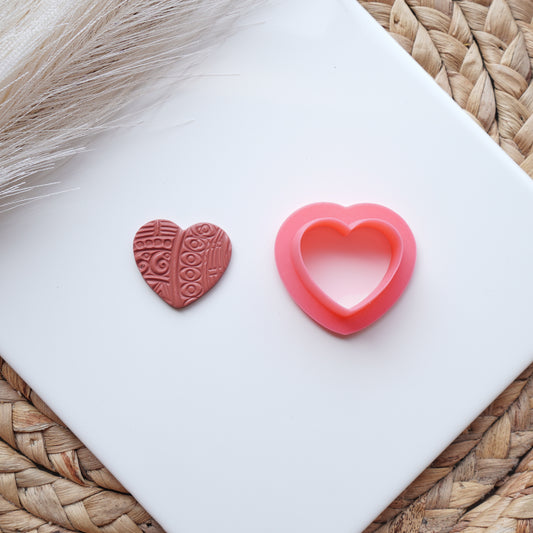DIY Retro Mod Polymer Clay Earrings
Rockrose Clay Clay Co.Share
Are you familiar with the Retro Mod Cane? I’ve recently become completely fascinated by Retro Mod Canes—the possibilities are endless, and the retro vibe is so fun! Every time I work with them, I can’t help but picture myself on the set of Mad Men or The Jetsons. With spring just around the corner, I wanted to create my own unique take on the Retro Mod Cane, using a spring color palette with that classic vintage feel. When I look at these earrings, I can’t help but imagine rocking a big beehive hairstyle, a sharp suit, and cute heels!

Now that we've set the scene, let's dive into the details. This cane technique is simple and fun, but color plays a huge role in how the finished cane turns out. The key to making this cane truly pop is achieving the perfect contrast with your color choices. With that in mind, let's go over the materials you'll need if you'd like to recreate this cane yourself.
Retro Mod Cane Video
Materials for Retro Mod Cane
 Before we dive in, let’s gather our materials. Here’s what I used for this project:
Before we dive in, let’s gather our materials. Here’s what I used for this project:
- Polymer clay in peacock, pearl, purple, and fuchsia. I used Sculpey Premo for this tutorial, but you can use any clay brand your prefer.
- Liquid Clay
- Tissue blade, ripple blade, and ruler.
- An extruder with a ½ cm square insert.
- An acrylic rod (having one with a handle helps with compressing the cane).
- Clay cutters:
- 18-gauge craft wire—I’m using bare copper, but feel free to use what works for you.
- Wire working tools: steel block, chasing hammer, chain-nose or flat-nose pliers, bail-making pliers, and a flush cutter.
- Ear wires of your choice.
- Some additional tools: a ceramic tile, deli paper, pasta machine, and an oven for curing.
Got everything ready? Great! Now, let’s mix some colors.
How to make the Retro Mod Cane
Creating the Perfect Color Palette
For this cane, I mixed a few custom colors (recipes shown below), but I also used two of my absolute favorite factory Sculpey colors—peacock and purple. When I mix color recipes, I like to keep my measurements consistent. To do this, I use a ¾" circle clay cutter and roll out my clay sheets at a #2 setting on my Atlas 180 pasta machine. Each cut circle weighs about a gram, and for this tutorial, we'll need approximately 10–11 grams of each color.
 Once your colors are mixed and ready, we can start building the Mod Cane!
Once your colors are mixed and ready, we can start building the Mod Cane!
Constructing the Mod Cane
Now comes the fun part—assembling the cane! Here’s how I do it:
- First, roll out each of your colors to a #3 thickness.
- Use a ¾" circle cutter to make clay circles that will fit nicely into the extruder.
- Stack those circles in a random order until the stack is about 3 inches high.

- Gently reduce the diameter of your stack so it fits into the extruder.

- Load it into the extruder and use a ½ cm square insert.
- Start extruding! Once you have a long piece, fold it in half and trim off any uneven ends.

- Cut the extruded clay into smaller segments and stack them together to form a square cane.





- Use an acrylic roller to compress and refine the cane, making sure everything sticks together nicely.

- Let the cane cool down before you slice into it—that way, you get crisp, clean cuts.
Now that our cane is ready, it’s time to turn it into earrings!
Shaping and Assembling the Earrings
Here’s where we bring everything together and create a stunning pair of earrings:
- Start by cutting four pieces of 18-gauge wire, each about 8.5 cm long.
- Shape and hammer two of the wires to embed into the drop shape (Mandorla Cutter).

- Shape and hammer the remaining two wires for a pass-through connection in the pear shape.
- For the backing clay, I mixed 14 parts pearl with 1 part fuchsia to get a soft, complementary shade.

- Slice thin, 2mm pieces from your Mod Cane and gently roll them together.

- Take your ripple blade and create a wavy pattern in both the cane sheet and the pink backing clay.


- Carefully align the ripple cuts and burnish them together so they fuse seamlessly.
- Roll out the backing clay to a #2 setting.

- Use the Mandorla and Pear cutters to cut out your shapes, embedding the hammered wires into the clay.


- Bake your pieces according to the polymer clay curing guidelines.

- Once they’re cooled, assemble them with your ear wires—and just like that, you have a gorgeous, handmade pair of earrings!
Final Thoughts
One of the things I love about this technique is how versatile it is. You can experiment with different color combinations and cutter shapes to make endless variations of this design. If you give it a try, I’d love to see your creations—feel free to share them with me on my Instagram @rockroseclay! Happy claying!





